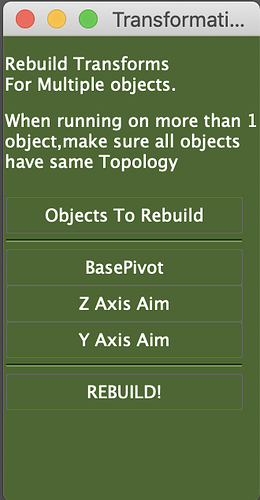Well, I found the Maya script. You need to use it in a specific way in order to make it work. Once the script is loaded, it pops up a tool. You selected the objects you want to orient and press the “objects to rebuilt” button. Then you select a vertex on the reference object, press “Base Pivot” button. You then select an edge oriented on the Z axis (and it has to touch the previous vertex) and click the “Z Axis Aim”. Then select another edge on the Y axis, again, touching the pivot vertex, “Y Axis Aim” button and finally you click the “REBUID” button. Maybe that can inspire you.
#en_transformRebuild.py
#What: for rebuilding object transforms, on one or multiple objects
#How: select objects first, click button. select poly components for z and Y axes.
# then run!
#note: Base pivot, Yaxis aim and Zaxis aim are calculated based on averaged center location of selected components.
import maya.cmds as cmds
import math
class en_transformRebuild(object):
def __init__(self,*args):
self.en_transformRebuildWin = 'en_transformRebuildWin'
if cmds.window(self.en_transformRebuildWin, exists=True):
cmds.deleteUI(self.en_transformRebuildWin)
self.buildWin()
def buildWin(self,*args):
self.en_transformRebuildWin = cmds.window(self.en_transformRebuildWin, t="Transformation Rebuilder",w=150, h=295,s=True,tb=True, bgc= [0.3,0.4,0.2])
cmds.columnLayout()
cmds.separator(style="none",w=150,h=10)
###BUTTONS
cmds.text( label='Rebuild Transforms')
cmds.text( label='For Multiple objects.')
cmds.separator(style="none",w=150,h=10)
cmds.text( label='When running on more than 1')
cmds.text( label='object,make sure all objects')
cmds.text( label='have same Topology')
cmds.separator(style="none",w=150,h=15)
cmds.rowColumnLayout( numberOfColumns=1 )
self.btnobjectSel = cmds.button(label = "Objects To Rebuild",ann="Select only Polygon Objects that you would like to rebuild transforms for", w=150,command= self.objectSel_RUN)
cmds.separator(style='in',w=150,h=10)
self.btnbaseVerts = cmds.button(label = "BasePivot",ann="Select The components(VERTS,Edges,Faces) you would like to have as the pivot location",w=150, command= self.baseVerts_RUN)
self.btntipVerts = cmds.button(label = "Z Axis Aim",ann="Select The components(VERTS,Edges,Faces) you would like to have as the Z aim axis",w=150, command= self.tipVerts_RUN)
self.btnorientVerts = cmds.button(label = "Y Axis Aim",ann="Select The components(VERTS,Edges,Faces) you would like to have as the Y aim axis",w=150, command= self.orientVerts_RUN)
cmds.separator(style='in',w=150,h=10)
self.btnxformRestore = cmds.button(label = "REBUILD!",ann="Run the script, based on the selections used above!",w=150, command= self.xformRestore_RUN)
cmds.showWindow(self.en_transformRebuildWin )
def objectSel_RUN(self,*args):
self.initialSel = cmds.ls(sl=True,l=True)
self.sourceObj = self.initialSel[0]
self.targetObjs = self.initialSel[1:]
def baseVerts_RUN(self,*args):
cmds.ConvertSelectionToVertices()
self.baseVertsTmp = cmds.ls(sl=True,l=True)
self.baseVertsObjTmp = cmds.ls(sl=True,o=True,l=True)[0]
self.baseVertsObj = cmds.listRelatives(self.baseVertsObjTmp,p=True,f=True)[0]
self.baseVerts = []
for self.obj in self.baseVertsTmp:
if str(self.baseVertsObj) in self.obj:
self.baseVertsTmp2 = self.obj.split(".")[-1]
self.baseVertsTmp2 = "." + str(self.baseVertsTmp2)
self.baseVerts.append(self.baseVertsTmp2)
def tipVerts_RUN(self,*args):
cmds.ConvertSelectionToVertices()
self.tipVertsTmp = cmds.ls(sl=True,l=True)
self.tipVertsObjTmp = cmds.ls(sl=True,o=True,l=True)[0]
self.tipVertsObj = cmds.listRelatives(self.tipVertsObjTmp,p=True,f=True)[0]
self.tipVerts = []
for self.obj in self.tipVertsTmp:
if str(self.tipVertsObj) in self.obj:
self.tipVertsTmp2 = self.obj.split(".")[-1]
self.tipVertsTmp2 = "." + str(self.tipVertsTmp2)
self.tipVerts.append(self.tipVertsTmp2)
def orientVerts_RUN(self,*args):
cmds.ConvertSelectionToVertices()
self.orientVertsTmp = cmds.ls(sl=True,l=True)
self.orientVertsObjTmp = cmds.ls(sl=True,o=True,l=True)[0]
self.orientVertsObj = cmds.listRelatives(self.orientVertsObjTmp,p=True,f=True)[0]
self.orientVerts = []
for self.obj in self.orientVertsTmp:
if str(self.orientVertsObj) in self.obj:
self.orientVertsTmp2 = self.obj.split(".")[-1]
self.orientVertsTmp2 = "." + str(self.orientVertsTmp2)
self.orientVerts.append(self.orientVertsTmp2)
def xformRestore_RUN(self,*args):
cmds.select(cl=True)
##################################################################################################
#GET SCALE OFFSETS################################################################################
##################################################################################################
self.edgeVal = 1
##get lengths of each target edge
self.lengthList = []
for self.obj in self.initialSel:
cmds.select(str(self.obj) + ".e["+str(self.edgeVal)+"]")
self.edgeSel=cmds.ls(sl=True,fl=True)
cmds.ConvertSelectionToVertices()
self.p=cmds.xform(self.edgeSel,q=True,t=True,ws=True)
self.length = math.sqrt(math.pow(self.p[0]-self.p[3],2)+math.pow(self.p[1]-self.p[4],2)+math.pow(self.p[2]-self.p[5],2))
self.lengthList.append(self.length)
#get average length
self.avgLength = sum(self.lengthList)/float(len(self.lengthList))
self.percentList = []
# percentage finder
for self.myLength in self.lengthList:
self.tempPercent = self.myLength/self.avgLength
self.percentList.append(self.tempPercent)
#################################################################################################
##################################Scale FIND END#################################################
#################################################################################################
self.jointList = []
#MAIN LOOP, APPLIES OFFSET SCALE, MAKES JOINTS, CONSTRAINTS, ETC.
for self.i,self.obj in enumerate(self.initialSel):
#MAKE NAMES OF VERTS FOR TARGET MESHES.
self.targBaseVerts = []
self.targTipVerts = []
self.targOrientVerts = []
for self.item in self.baseVerts:
self.tmp1 = str(self.obj) + str(self.item)
self.targBaseVerts.append(self.tmp1)
for self.item in self.tipVerts:
self.tmp2 = str(self.obj) + str(self.item)
self.targTipVerts.append(self.tmp2)
for self.item in self.orientVerts:
self.tmp3 = str(self.obj) + str(self.item)
self.targOrientVerts.append(self.tmp3)
#get position of base verts
self.posBase = cmds.xform(self.targBaseVerts, q=True, ws=True, t=True)
self.xposBase = self.posBase[0::3]
self.yposBase = self.posBase[1::3]
self.zposBase = self.posBase[2::3]
self.xposBase = sum(self.xposBase)/len(self.xposBase)
self.yposBase = sum(self.yposBase)/len(self.yposBase)
self.zposBase = sum(self.zposBase)/len(self.zposBase)
#get position of tip verts
self.posTip = cmds.xform(self.targTipVerts, q=True, ws=True, t=True)
self.xposTip = self.posTip[0::3]
self.yposTip = self.posTip[1::3]
self.zposTip = self.posTip[2::3]
self.xposTip = sum(self.xposTip)/len(self.xposTip)
self.yposTip = sum(self.yposTip)/len(self.yposTip)
self.zposTip = sum(self.zposTip)/len(self.zposTip)
#get position of orient verts
self.posOrient = cmds.xform(self.targOrientVerts, q=True, ws=True, t=True)
self.xposOrient = self.posOrient[0::3]
self.yposOrient = self.posOrient[1::3]
self.zposOrient = self.posOrient[2::3]
self.xposOrient = sum(self.xposOrient)/len(self.xposOrient)
self.yposOrient = sum(self.yposOrient)/len(self.yposOrient)
self.zposOrient = sum(self.zposOrient)/len(self.zposOrient)
#create locators based on positions
self.myOrientLocator = cmds.spaceLocator(n='orientLocator')[0]
cmds.setAttr(str(self.myOrientLocator) + '.translateX', self.xposOrient)
cmds.setAttr(str(self.myOrientLocator) + '.translateY', self.yposOrient)
cmds.setAttr(str(self.myOrientLocator) + '.translateZ', self.zposOrient)
self.myTipLocator = cmds.spaceLocator(n='tipLocator')[0]
cmds.setAttr(str(self.myTipLocator) + '.translateX', self.xposTip)
cmds.setAttr(str(self.myTipLocator) + '.translateY', self.yposTip)
cmds.setAttr(str(self.myTipLocator) + '.translateZ', self.zposTip)
cmds.select(self.obj,r=True)
#NEED TO MOVE PIVOT TO BASE LOC
cmds.move( self.xposBase,self.yposBase,self.zposBase, str(self.obj) + ".scalePivot", str(self.obj) + ".rotatePivot",ws=True)
#scale up object based on offsets
#cmds.scale(1/percentList[i],1/percentList[i],1/percentList[i], str(obj),r=True)
cmds.select(cl=True)
#######JOINTS#######
self.mainJoint = cmds.joint(p=(self.xposBase,self.yposBase,self.zposBase), n= str(self.obj) + "_joint")
self.jointList.append(self.mainJoint)
cmds.scale(self.percentList[self.i],self.percentList[self.i],self.percentList[self.i], self.mainJoint,r=True)
#aim constraint. get orientation for joint
cmds.select(self.myTipLocator,r=True)
cmds.select(self.mainJoint,add=True)
self.myAimConstraint = cmds.aimConstraint(offset=(0 ,0 ,0),weight=1, aimVector=(0, 0, 1), upVector=(0, 1, 0), worldUpType="object", worldUpObject=str(self.myOrientLocator))
cmds.delete(self.myAimConstraint)
cmds.delete(self.myOrientLocator,self.myTipLocator)
cmds.parentConstraint(self.mainJoint,self.obj,mo=True,w=True)
cmds.scaleConstraint(self.mainJoint,self.obj,mo=True,w=True)
#####################################################################
############################BAKE TRANSFORMS##########################
#####################################################################
self.newJoints = cmds.duplicate(self.jointList)
#move joints back to origin, in order to send object back by themselves.
for self.obj in self.jointList:
cmds.setAttr(str(self.obj) + ".tx",0)
cmds.setAttr(str(self.obj) + ".ty",0)
cmds.setAttr(str(self.obj) + ".tz",0)
cmds.setAttr(str(self.obj) + ".rx",0)
cmds.setAttr(str(self.obj) + ".ry",0)
cmds.setAttr(str(self.obj) + ".rz",0)
cmds.setAttr(str(self.obj) + ".sx",1)
cmds.setAttr(str(self.obj) + ".sy",1)
cmds.setAttr(str(self.obj) + ".sz",1)
#DELETE CONSTRAINTS and freez transforms on original objects
for self.obj in self.initialSel:
self.myPConst = cmds.listRelatives(self.obj,ad=True,typ="parentConstraint")
self.mySConst = cmds.listRelatives(self.obj,ad=True,typ="scaleConstraint")
cmds.delete(self.myPConst)
cmds.delete(self.mySConst)
cmds.makeIdentity(self.obj,apply=True,t=True,r=True,s=True)
#DELETE ORIGINAL JOINTS
cmds.delete(self.jointList)
#send objects to joint locations
for self.obj,self.jnt in zip(self.initialSel,self.newJoints):
self.myTX =cmds.getAttr(str(self.jnt) +".tx")
self.myTY =cmds.getAttr(str(self.jnt) +".ty")
self.myTZ =cmds.getAttr(str(self.jnt) +".tz")
self.myRX =cmds.getAttr(str(self.jnt) +".rx")
self.myRY =cmds.getAttr(str(self.jnt) +".ry")
self.myRZ =cmds.getAttr(str(self.jnt) +".rz")
self.mySX =cmds.getAttr(str(self.jnt) +".sx")
self.mySY =cmds.getAttr(str(self.jnt) +".sy")
self.mySZ =cmds.getAttr(str(self.jnt) +".sz")
cmds.setAttr(str(self.obj) + ".tx", self.myTX)
cmds.setAttr(str(self.obj) + ".ty", self.myTY)
cmds.setAttr(str(self.obj) + ".tz", self.myTZ)
cmds.setAttr(str(self.obj) + ".rx", self.myRX)
cmds.setAttr(str(self.obj) + ".ry", self.myRY)
cmds.setAttr(str(self.obj) + ".rz", self.myRZ)
cmds.setAttr(str(self.obj) + ".sx", self.mySX)
cmds.setAttr(str(self.obj) + ".sy", self.mySY)
cmds.setAttr(str(self.obj) + ".sz", self.mySZ)
cmds.delete(self.jnt)
en_transformRebuild()


